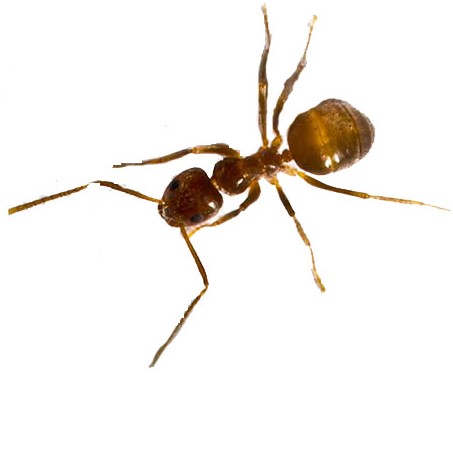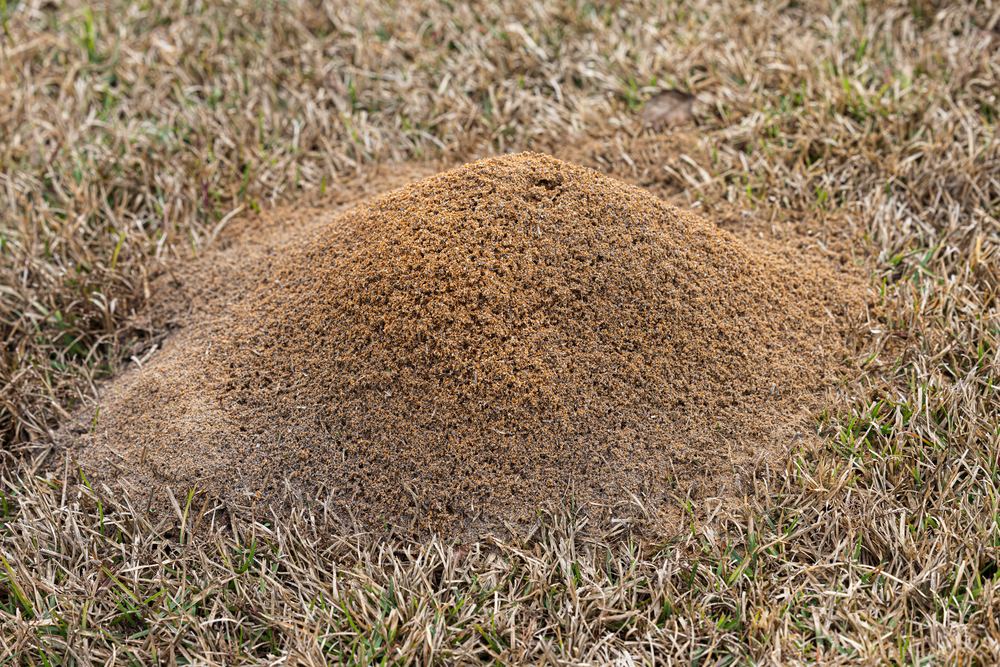February has arrived, bringing with it a warm burst of love to help get us through the remaining winter. Yes, Valentine’s Day is nearly here. Stores are full of heart-shaped goodies, every love song plays softly in the air, and it seems like the world has been wrapped in shades of pink and red. But while you may be feeling Crazy in Love as you plan a romantic evening with your sweetie, there may be something lurking in your home getting ready to play a Wicked Game and make you feel just plain old Crazy: the tawny crazy ant.

What do Tawny Crazy Ants Look Like?
These small ants are monomorphic, meaning virtually all adults have the same appearance. They are 1/8 inch long, reddish brown in color, covered with many long hairs, and they have particularly long antennae and legs. Occasionally, winged reproductive males and females will be produced, but these ants are not known for flying, unlike carpenter ants that can often be seen swarming during their reproductive season. Tawny crazy ant queens are often a bit larger and darker than the rest of the ants in the colony, and each colony has numerous queens, which will produce millions of “naked” (without cocoon) larvae within a colony.
Why Are They Called Tawny Crazy Ants?
Tawny crazy ants, also known as Rasberry crazy ants received their name for several reasons. “Tawny” comes simply from the color of the ants and is a helpful way to distinguish this ant from other types of crazy ants. The alternate name of “Rasberry” comes from the name of the man who first discovered this ant near Houston in 2002 (Tom Rasberry). Perhaps more importantly, however, is why they were called “crazy ants” as this gives an important clue to identifying these pests before you have to pull out a magnifying glass or microscope…their behavior. These ants were called “crazy” due to their quick, irregular movements. Where other ants follow a distinct foraging trail and seem to march orderly along that trail, the crazy ants forage erratically; that randomness combined with their gangly limbs gives these ants a particularly unwieldy appearance.

Where do Tawny Crazy Ants Live?
Unfortunately, these ants are extremely pervasive and are excellent survivors. Believed to originate in tropical South America (i.e. Columbia and Brazil), these pests prefer tropical and subtropical areas and as such have successfully invaded Texas, starting with the Gulf Coast and spreading outward.
Not only are tawny crazy ants successful in multiple countries, but they thrive both indoors and outdoors. Indoors, you can expect to see them near food sources if they are foraging, or nesting in warm, secluded areas (i.e. wall voids, in electronics, under carpeting, in potted plants, etc.). Generally, they will nest a good distance from their foraging area, and most often they will nest outdoors. You can find them in places like trash bins, crevices in plants and trees, in mulch, under yard items (i.e. rocks, stumps, wood piles, etc.), in rotten wood, under leaf litter, and in soil. Importantly, unlike fire ants, tawny crazy ants do not create noticeable nest mounds, which can make their nests much more difficult to locate.
These highly prolific ants grow their colonies by “budding,” which means that they establish new colonies at the periphery of their existing one, rather than creating a new one some distance away. As such, this can lead to gigantic, sprawling nesting areas of tawny crazy ants. On average, they will spread around 65 feet per month in neighborhoods, and nearly 100 feet per month in industrial areas. This means that left unchecked you could rapidly be facing an infestation of millions of ants.
What do Tawny Crazy Ants Eat?
As omnivores, these ants can thrive on a widely varied diet. From consuming insects (alive and dead), to fruits, seeds, honeydew (aphid excrement), and many human foods, there are very few places these pests can’t find a good meal. Two of the most common meals for tawny crazy ants are sweet parts of plants( including over-ripe fruit), and honeydew, which they obtain by “tending” other insects, such as aphids, scale, and mealy bugs.

Are Tawny Crazy Ants Dangerous?
Though tawny crazy ants can bite and can excrete formic acid from their acidopore on the end of their abdomen, they aren’t known to pose any significant danger to humans, other than a brief, sharp pain if you’re bitten. However, they are far from being simply a nuisance pest. Presenting a danger to livestock, homes and equipment, plants, and the ecosystem, these little ants are a pest to be reckoned with.
As an extremely successful invasive species, the tawny crazy ant is even capable of fighting and winning against the more commonly known invasive ant: the imported red fire ant. But the bigger concern isn’t one invasive supplanting another, it’s the threat they pose to native insect and wildlife populations. In areas where tawny crazy ants have created huge, dense populations, they have been known to displace native ants and arthropods, leading to a decline in bird populations, and potentially even greater ramifications down the road.
In agriculture, they present a two-fold threat. First, they have been known to directly harm livestock: asphyxiating smaller animals (like chickens) and attacking eyes, noses, and hooves of larger animals (like cattle). Secondly, they can lead to indirect crop damage by both encouraging higher populations of plant pests (like aphids) and by translocating pathogenic organisms.
For homes and business, they present a significant danger to electrical equipment. They are known to heavily infest these areas, causing short circuits and equipment failure of anything from A/C units to TVs to the outlets themselves.

How do you Prevent Tawny Crazy Ants?
When it comes to prevention, the single most helpful thing you can do is maintain a regular pest control treatment plan with The Bug Dude. Not only can our expert technicians eliminate the tawny crazy ants and their insect food sources, they can keep their trained eye on conducive areas in and around your home to help spot a problem before it becomes an infestation.
The other main steps you can take to help prevent an infestation from these pests are:
- Remove all yard waste and leaf litter
- As much as possible, remove all items that sit directly on the ground
- Reduce the usage of sprinkler and irrigation systems and ensure the yard has good drainage
- Keep mulch at least 1 foot away from your foundation and ensure it is less than 2 inches thick
- Seal visible cracks and crevices on the exterior of your home
- Maintain good sanitation practices in and around your home
- Thoroughly inspect potted plants for possible pests before transporting them
- If you or your belongings have been in an infested area, ensure that you perform a thorough inspection for ants before entering a non-infested area
Since the ants are less active during the winter months, it’s an excellent time to take preventative measures before the invasion arrives in the summer.
How do you Eliminate Tawny Crazy Ants?
At the first sign of an ant problem, call The Bug Dude at 800-310-BUGS (2847). When it comes to tawny crazy ants, eliminating the issue without professional help is virtually impossible. These pests are notorious for rapidly rebounding from partial treatments, which means that without expert help identifying and treating all the sources of the issue, you could find yourself in a never-ending battle with these ants. Additionally, tawny crazy ants are particularly tricky to treat for and need a specific combination of professional-grade products to effectively attract and eliminate them.
So don’t risk this Valentine’s Day being ruined by ants, call The Bug Dude ASAP so you can have peace At Last and get back to the Wonderful World of your Endless Love.
Further Reading:
“Crazy Ants” – Brackenridge Field Laboratory, College of Natural Sciences, The University of Texas at Austin
“Tawny Crazy Ant, Rasberry Crazy Ant” – Texas Invasive Species Institute
“Tawny (Rasberry) Crazy Ant, Nylanderia fulva” – Urban and Structural Entomology Program at Texas A&M University
“Invasive Ants” – Texas Parks & Wildlife
Author Bio: Alissa Breach has been gaining knowledge and experience around pest control concerns over the last 12 years while working for Mid-Cities Pest Control. She has a creative writing BA from UW-Madison and is always pursuing new and interesting writing projects.




